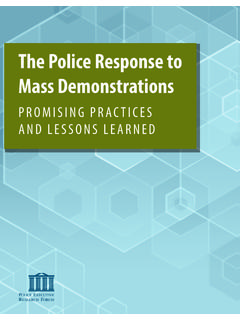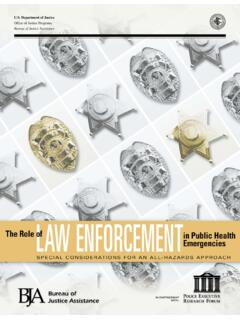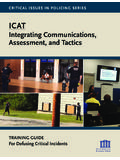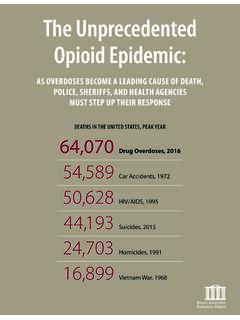Transcription of The Workforce Crisis, and What Police Agencies Are Doing ...
1 The Workforce Crisis, and What Police Agencies Are Doing About ItThe Workforce Crisis, and What Police Agencies Are Doing About ItSEPTEMBER 2019 The points of view expressed herein are the authors and do not necessarily represent the views of all Police Executive Research Forum Executive Research Forum, Washington, 20036 Copyright 2019 by Police Executive Research ForumAll rights in the United : 978-1-934485-53-8 Graphic Design by Dave by Greg Dohler. Cover photos, clockwise from upper left, courtesy of the Tucson Police Department; the Clearwater, FL Police Department; the New York City Police Department; the Metropolitan Police , United Kingdom; the Tempe, AZ Police Department; and the Volusia County, FL Sheriff s | PAG E 5 Executive Summary: The Workforce Crisis, and What Police Agencies Are Doing About It | 712 Takeaways to Improve Recruitment and Retention | 12 How PERF Surveyed Police Agencies on Recruitment and Retention Issues | 17 Survey Methodology | 17 Overview of Survey Respondents | 17 Demographics of Responding Agencies | 18 Recruitment and Retention: Trends and Statistics | 19 The Current Crisis Has Deep Roots | 22 The Key Challenge: Finding Recruits Who Have the Skills for Policing Today | 231.
2 Community Engagement | 242. Changes in Technology | 243. The Growing Roles of Police in Handling Social Problems | 25 Sidebar: Why Are Fewer People Considering a Career in Policing? | 27 Sidebar: A Fresh Perspective: Hearing from Officers New to the Profession | 28 Identifying Specific Challenges in Recruitment and Retention | 29 Recruitment Challenges | 29 Competition Between Agencies | 30 Retention Challenges | 31 Sidebar: Recruitment and Retention Challenges in Federal Agencies | 32 CONTENTSF inding Solutions: What Agencies Are Doing to Improve Recruitment and Retention | 33 Recruitment Incentives | 33 Expanding the Pool of Candidates | 34 Pursuing Non-Traditional Candidates | 37 Sidebar: Creating a Farm System to Grow Your Own Police Officer Candidates | 38 Sidebar: Police Now A New Way of Thinking about Police Careers in the United Kingdom | 40 Sidebar: Survey of Criminal Justice Students Reveals Ways to Improve Recruiting | 44 Refining the Recruitment Process to Attract Today s Applicants | 46 Give Applicants a Realistic Picture of Policing | 48 Retaining the Officers You Recruit | 51 Broadening Officers Experiences through Professional Development Opportunities | 52 Supporting Employees Needs for Work-Life Balance | 54 Promoting and Facilitating Officers Wellness | 56 Sidebar: Reimagining the Police Workforce | 57 Conclusion: The Recruiting Crisis Isn t Only About Recruiting | 58 Participants: The Changing Dynamics of Policing and the Police Workforce Conference December 4, 2018 Washington, DC | 605 AcknowledgmentsACKNOWLEDGMENTSMost law enforcement Agencies are sensing a crisis in their ability to recruit new officers, and to hold on to the ones they have.
3 For more than a year, we have been reading news stories about Police and sheriffs departments that simply can t find enough qualified applicants to hire and train, no matter how hard they it is not simply a matter of Police sala-ries being too low, or other problems that can be addressed fairly easily. There seem to be fewer young people today who have any interest in policing. So when PERF decided to hold a confer-ence on the Police recruiting crisis, we knew we needed to hear the perspectives of officers at various stages in their policing careers, not just Police chiefs. We asked Police executives to bring to the meeting an officer who was just at the start of his or her career. Of the 250 participants at the meeting, approximately 20 were officers and deputies. These officers provided first-hand information about their motivations for joining law enforcement, what they hoped to get out of the job, and what would encourage them to stay in the profession.
4 These are the essential questions that Police and sheriffs departments across the country are asking as they try to address issues of recruitment and retention. PERF would like to thank these officers, and all of the participants, for sharing their experi-ences and promising practices at our meeting, The Changing Dynamics of Policing and the Police Workforce , which was held in Washington, on December 4, relies on its members for guidance and information on the most pressing issues in policing, and we often gather baseline data through surveys. For this project, PERF fielded an extensive survey on recruitment and retention. I want to thank all of the Agencies that participated in our Police Workforce survey. The information that PERF received provided a solid basis for our conference and this publication. Your responses shed light on the difficulties that Police are having nationwide in recruitment and retention, as well as innovative steps that are being taken to address those thanks to the Agencies that helped pilot the survey: the Metropolitan Police Depart-ment of Washington, DC; the Portland, OR Police Bureau; the Punta Gorda, FL Police Department; and the San Diego, CA Sheriff s Office.
5 Each of these Agencies provided PERF with feedback that helped shape the final draft of the survey. Addi-tional thanks to Ben Haiman, Executive Director of the Metropolitan Police Department s Professional Development Bureau, for helping to organize a focus group of recently hired officers and recruits who aided PERF s research for this meeting. Without the generous support of the Howard G. Buffett Foundation, this project would not have been possible. Howard Buffett, who served as Sheriff in Macon County, IL, saw this issue firsthand and considers it a national problem. His support has been invaluable. PERF would like to thank the Foundation for its support of this initiative and the advancement of law enforce-ment across the United would also like to thank the PERF staff members who designed and carried out this initia-tive. Kevin Morison, PERF s Chief Operations 6 AcknowledgmentsChuck WexlerExecutive DirectorPolice Executive Research ForumWashington, Officer, led the project team and ensured its success.
6 Sarah Mostyn, PERF Research Associate, was the lead author of this report. Research Associ-ates Jeremy Barnum and Allison Heider and Senior Research Assistant Amanda Barber contributed sidebars to the report. Sarah and Project Assistant Nora Coyne oversaw meeting planning and logis-tics. Research Associate Rachael Arietti led the design of the survey and conducted the analysis, with assistance from Deputy Director of Research Sean Goodison and Project Assistant Coyne. Senior Research Assistant Nate Ballard provided support throughout the implementation of the survey and in the data collection. Several staff members conducted pre-meeting interviews and provided support at the meeting: Senior Associate Dan Alioto; Project Assistant Coyne; and Research Associates Mostyn, Heider, and Matt Harman. Other staff members who assisted at the meeting included Director of the Center for Applied Research and Management Tom Wilson, Assis-tant Director of Communications James McGinty, Research Associates Barnum and Madeline Sloan, Senior Research Assistant Lauren Anderson, and Research Assistant Hyla Jacobson.
7 Communica-tions Director Craig Fischer edited this report and oversaw production. PERF s graphic designer, Dave Williams, designed and laid out the report, which includes photos taken by Greg Dohler. Executive Assistant Soline Simenauer helped to keep me organized and on track for this meeting. We hope that this report will serve as a wake-up call to local and state government leaders, educators, the news media, and the public about the Workforce crisis facing policing. Our report will help Agencies that are struggling with recruitment and retention by providing fresh ideas and promising practices. The policing profes-sion must adapt to a 21st century Workforce , which differs in many ways from previous genera-tions, in order to respond to the needs of their communities. 7 Executive Summary: The Workforce Crisis, and What Police Agencies Are Doing About ItEXECUTIVE SUMMARY:THE Workforce CRISIS, AND WHAT Police Agencies ARE Doing ABOUT ITThe policing profession is facing a Workforce people are applying to become Police officers, and more people are leaving the profes-sion, often after only a few years on the job.
8 These trends are occurring even as many Police and sheriffs offices are already short-staffed and facing challenges in developing a diverse Workforce crisis is affecting law enforce-ment Agencies of all sizes and types large, medium, and small; local, state, and federal. And it is hitting departments in all parts of the country. There are ominous signs that the Workforce crisis in policing may be getting worse. Traditional sources of job applicants the military and family members of current officers are diminishing. A robust economy and strong job growth are creating more options for people entering the labor market, so Police Agencies are facing more competition in hiring. And the often-rigid, quasi-military organi-zational structure of most Police Agencies does not align with the preferences of many of today s job THE BAR IN THE MIDST OF A CRISIS: An impor-tant factor complicating the situation is the fact that the work of policing itself is changing.
9 The work of Police officers is becoming more chal-lenging. Criminal offenders are committing new types of cyber-crime, and are using computers to commit old types of crime in new ways, so offi-cers must understand and be comfortable with new technologies. Furthermore, today s Police officers increasingly are being asked to deal with social problems, such as untreated mental illness, substance abuse, and homelessness. As a result, the skills, temperament, and life experiences needed to succeed as an officer are becoming more complex. So even as Police departments are strug-gling to get enough applicants in the door, they need to be raising the bar and looking for applicants with a wider array of talents and are the conclusions from the Police Exec-utive Research Forum s research into the changing dynamics of policing and the Police Workforce . PERF explored these issues at a national confer-ence on December 4, 2018 in Washington, DC.
10 The meeting was attended by approximately 250 law enforcement leaders, recently hired Police officers, researchers, and other subject matter experts. 1. The term Workforce crisis was coined by author Ken Dychtwald and his colleagues in their 2006 book that warned of a coming shortage of talent and skills in the private sector. The concept readily applies to policing today. Dychtwald, Ken, Erickson, Tamara J., Morison, Robert. (2006) Workforce Crisis: How to Beat the Coming Shortage of Skills and Talent. Boston, Mass.: Harvard Business School Summary: The Workforce Crisis, and What Police Agencies Are Doing About ItTHERE ARE NEW APPROACHES AND SOLUTIONS: It s not an exaggeration to say that the Workforce crisis in policing is dire. But PERF s research and the national conference produced interesting ideas and promising practices for moving forward. Agencies are experimenting with new ways to expand their applicant pools, especially by attracting non-traditional candidates who might not otherwise have considered Police work.
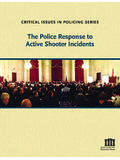

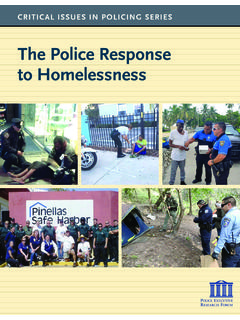

![[Page Intentionally Blank] - Police Executive …](/cache/preview/6/9/5/6/0/0/0/f/thumb-6956000f3f6abdc7d6fe85fa330b8ad5.jpg)
